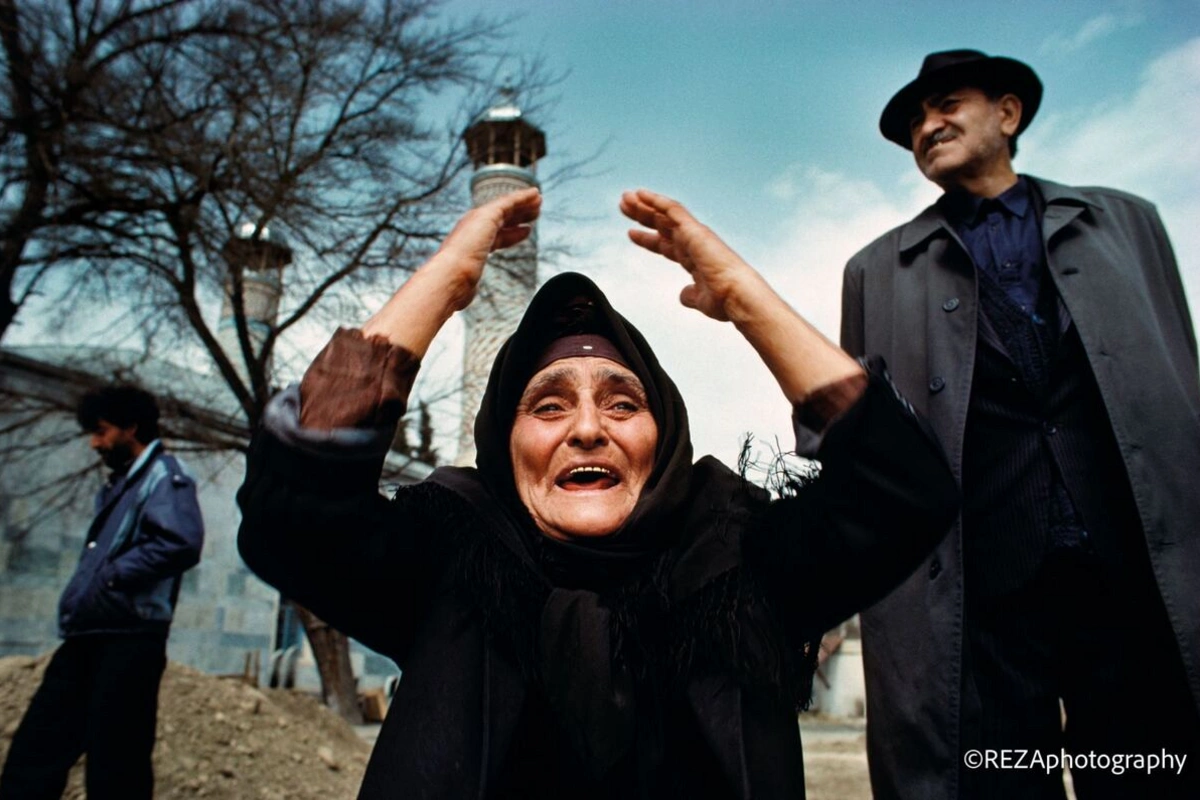
Remembering victims of the Khojaly Massacre, the bloodiest massacre of the First Karabakh War by Armenian armed forces.
Image: Reza Deghati
“Nobody was killed like the people from Khojaly. I am still alive, but I lost two sons,” says Humay Abbasova, one of a few Khojaly Massacre survivors. She remembers walking barefoot through the forest on the way to Agdam and eating snow, trying to escape the Armenian terror on the night of 26 February1992. “My husband had frostbitten fingers and I had frostbitten feet. Many died in the forest,” Mrs. Abbasova recalled. Unfortunately, after some time they were all captured and held hostage in Askeran. “There were beatings... the men had urine thrown over them... they were tortured, spat upon, killed like animals...[the Armenians] threatened to burn us alive... We were exchanged for bodies and prisoners—one commander for fifty hostages…” On the way back, her husband died due to the beatings he went through.
The Khojaly Massacre was the night of terror, when 32 years ago, Armenian forces killed at least 613 Azerbaijanis, with more people still missing, in the Karabakh region’s town of Khojaly. Among the victims were 106 women, 63 children, and 70 elderly. The bloody massacre erupted as part of the First Karabakh War which lasted from 1988 to 1994 and resulted in 30,000 deaths, one million Azerbaijani refugees, and the Armenian occupation of the Karabakh region together with seven surrounding regions of de jure Azerbaijani land.
This year’s anniversary of the massacre will be the first since Azerbaijan regained control over the whole territory of Karabakh in the fall of 2023. Until recently, Khojaly remained under Armenian control, as even after the Second Karabakh War, Khojaly wasn’t one of those returned. Finally, on 15 October 2023, the President of Azerbaijan, Ilham Aliyev, raised the flag of Azerbaijan in Khojaly.
However, even after all these years and the recent return of the territories, the tragedy of 26 February continues to haunt Azerbaijan and its people.
In the 1990s, photos of brutally murdered and frozen-to-death children and elderly made it to the front pages of world-renowned newspapers, including The New York Times, The Washington Post, The Guardian, The Independent, and The Times.
Former President of Armenia, Serzh Sargsyan, in his December 2000 interview with Thomas de Waal, a British journalist and writer, who built his career analyzing the war-torn Caucasus, said, “Before Khojaly, the Azerbaijanis thought that they were joking with us, they thought that the Armenians were people who could not raise their hand against the civilian population. We needed to put a stop to all that. And that’s what happened.”
A Khankendi-born Armenian, Sargsyan, who at the time of the interview was Armenia’s Minister of Defence, began his political career as one of the organizers of the so-called “NKR Defence Army” during the First Karabakh War. He has been called “a war criminal” who “was directly engaged in killing Azerbaijani civilians” by President Aliyev’s adviser, Hikmet Hajiyev.
On 3 March 1992, The New York Times reported that “Azerbaijani officials and journalists who flew briefly to the region by helicopter brought back three dead children with the backs of their heads blown off. They said that shooting by Armenians had prevented them from retrieving more bodies.” The article includes quotes from officials and journalists who had seen “bodies scattered over the area.” They reported seeing scalped women and children, bodies “lying there like flocks of sheep,” and Armenian forces firing at them when they tried to retrieve the bodies. Reuters photographer, Frederique Lengaigne, reported seeing two trucks with 35 dead men in each. “Some had their heads cut off, and many had been burned.”
On 23 March 1997, Human Rights Watch issued a Response to Armenian Government Letter on the town of Khojaly, Nagorno-Karabakh, stating that “we place direct responsibility for the civilian deaths with Karabakh Armenian forces. Indeed, neither our report nor that of Memorial includes any evidence to support the [Armenian] argument that Azerbaijani forces obstructed the flight of, or fired on Azeri civilians.”
Despite the photographic and video evidence and world organizations, communities, and even Armenia’s former president verifying the legitimacy of the atrocities committed by the Armenian forces, some people have refused to accept the truth of the events of that night, a denial that is continuously spreading online. In the words of the aforementioned journalist de Waal, “keen to minimize their own acts of aggression, many Armenians have sought to deny that their soldiers killed civilians that day.” Today, 32 years later, Azerbaijanis have to continue debunking lies, demanding an apology, and organizing rallies and demonstrations to get justice for the victims of Khojaly.
That is how the Justice for Khojaly International Awareness Campaign came into existence. Launched in 2008 by Leila Aliyeva, daughter of President Ilham Aliyev, the campaign has since become widespread among members of the Azerbaijani diaspora worldwide. By organizing memorials, marches, and demonstrations in different cities around the world, the Azerbaijanis continue fighting for the recognition of the massacre and demanding justice for the victims.
Forgetting the Khojaly massacre would mean giving up on innocent lives and allowing history to repeat itself. We cannot undo the events of the past, we cannot bring back the dead, but we owe it to the victims to remember them and to continue talking about the night that took away at least 613 civilian lives in Khojaly.
Share on social media